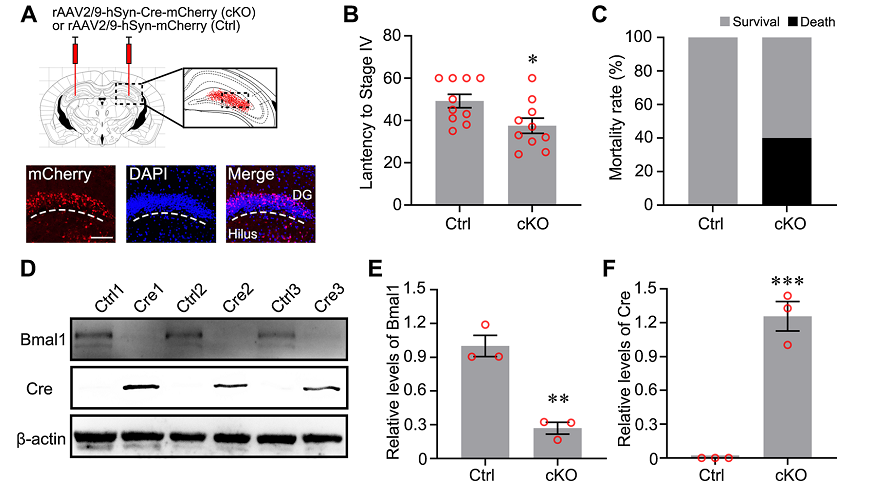AAV-Cre or control virus were used to clarify the effect of decreased Bmal1 on epileptogenesis. (From
BrainVTA)
The viruses used in this article from BrainVTA are in the table below
|
CRE Recombinase |
PT-0407 rAAV2/9-hSyn-Cre-mCherry-WPRE-pA |
|
Control |
PT-0100 rAAV2/9-hSyn-mCherry-WPRE-pA |
Hao Wu, Yong Liu, Lishuo Liu, Qiang Meng, Changwang Du, Kuo Li, Shan Dong, Yong Zhang, Huanfa Li, Hua Zhang
Pub Date: 2021-07-14,
DOI: 10.1186/s13041-021-00824-4,
Email: sales@brainvta.com
Clock genes not only regulate the circadian rhythm of physiological activities but also participate in the pathogenesis of many diseases. Previous studies have documented the abnormal expression of clock genes in epilepsy. However, the molecular mechanism of brain and muscle Arnt-like protein 1 (Bmal1), one of the core clock genes, in the epileptogenesis and seizures of temporal lobe epilepsy (TLE) remain unclear. We first investigated the levels of Bmal1 and other clock proteins in the hippocampus of subjects with epilepsy to define the function of Bmal1. The levels of Bmal1 were decreased during the latent and chronic phases in the experimental group compared with those in the control group. Knockout of Bmal1 in hippocampal dentate gyrus (DG) neurons of Bmal1flox/flox mice by Synapsin 1 (Syn1) promoter AAV (adeno-associated virus) lowered the threshold of seizures induced by pilocarpine administration. High-throughput sequencing analysis showed that PCDH19 (protocadherin 19), a gene associated with epilepsy, was regulated by Bmal1. PCDH19 expression was also decreased in the hippocampus of epileptic mice. Furthermore, the higher levels of Bmal1 and PCDH19 were detected in patients with no hippocampal sclerosis (no HS) than in patients with HS International League Against Epilepsy (ILAE) type I and III. Altogether, these data suggest that decreased expression of clock gene Bmal1 may participate in epileptogenesis and seizures via PCDH19 in TLE.
 Figure 1. Conditional knockout (cKO) of Bmal1 in DG neurons increased the susceptibility to seizures.
Figure 1. Conditional knockout (cKO) of Bmal1 in DG neurons increased the susceptibility to seizures.
In this study, the authors explored the potential role of Bmal1 in epileptic activity and seizures. The results suggest that decreased expression of clock gene Bmal1 may participate in epileptogenesis and seizures via PCDH19 in TLE.
BrainVTA offers viral vector construction & virus packaging services for AAV, LV, RABV, PRV, HSV and VSV that help researchers explore questions about genes, neurons, circuitry structure, function of brain network, mechanism and treatment of diseases.
If you have any needs, just email us at
sales@brainvta.com.
